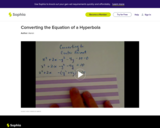
This lesson show how to convert the equation of a hyperbola from one form to another form. [4:02]
- Subject:
- Mathematics
- Material Type:
- Audio/Video
- Provider:
- Sophia Learning
- Date Added:
- 12/01/2023

This lesson show how to convert the equation of a hyperbola from one form to another form. [4:02]

This lesson shows how to convert the equation of a hyperbola from one form to another form.

This lesson [2:16] show how to convert the equation of a hyperbola from one form to another form. It is 2 of 7 in the series titled "Converting the Equation of a Hyperbola

This video lesson [3:31] shows how to convert the equation of a hyperbola from one form to another form. It is 4 of 7 in the series titled "Converting the Equation of a Hyperbola."

Converting from a longer number to exponential notation is covered in this lesson. [1:13] It is 12 of 13 in the series titled "Converting to Exponential Notation."

The process for converting a number raised to a power within a root symbol to a number raised to a fraction exponent is demonstrated in this video.

The process for converting a number raised to a power within a root symbol to a number raised to a fraction exponent is demonstrated in this video. This lesson [2:47] is 1 of 15 in the series titled "Converting to Fractional Exponent Form."

The process for converting a number raised to a power within a root symbol to a number raised to a fraction exponent is demonstrated in this video. This lesson [2:29] is 13 of 15 in the series titled "Converting to Fractional Exponent Form."

The process for converting a number raised to a power within a root symbol to a number raised to a fraction exponent is demonstrated in this video. This lesson [2:14] is 14 of 15 in the series titled "Converting to Fractional Exponent Form."

The process for converting a number raised to a power within a root symbol to a number raised to a fraction exponent is demonstrated in this video. This lesson [2:36] is 3 of 15 in the series titled "Converting to Fractional Exponent Form."

The process for converting a number raised to a power within a root symbol to a number raised to a fraction exponent is demonstrated in this video. This lesson [1:18] is 4 of 15 in the series titled "Converting to Fractional Exponent Form."

The process for converting a number raised to a power within a root symbol to a number raised to a fraction exponent is demonstrated in this video. This lesson [3:50] is 5 of 15 in the series titled "Converting to Fractional Exponent Form."

Students will learn how to convert from a fraction with an exponent in the denominator to a whole number with a negative exponent.

This lesson demonstrates how to rewrite a very large number in scientific notation. It is 5 of 10 in the series titled "Converting to Scientific Notation." Includes short multiple-choice quiz. [2:29]

This lesson [3:49] demonstrates conversion from a long number to scientific notation. It is 1 of 10 in the series titled "Converting to Scientific Notation."

This lesson [8:14] will demonstrate how to use slope, midpoint, and distance formulas to determine from the coordinates of the vertices if a quadrilateral is an isosceles trapezoid in a coordinate plane. It is 2 of 5 in the series titled "Coordinate Geometry of Isosceles Trapezoids."

This lesson will demonstrate how to use slope, midpoint, and distance formulas to determine from the coordinates of the vertices if a quadrilateral is a parallelogram in a coordinate plane. Students can check their understanding with an assessment. [12:13]

This lesson [7:43] will demonstrate how to use slope, midpoint, and distance formulas to determine from the coordinates of the vertices if a quadrilateral is a parallelogram in a coordinate plane. It is 3 of 6 in the series titled "Coordinate Geometry of Parallelograms."

Coordinate geometry of rectangles is investigated in this video lesson. The tutorial demonstrates how to use the midpoint, distance, and slope formulas to determine if a quadrilateral is a rectangle on a coordinate plane. [17:26]

This lesson [8:39] will demonstrate how to use slope, midpoint, and distance formulas to determine from the coordinates of the vertices if a quadrilateral is a rectangle in a coordinate plane. It is 1 of 5 in the series titled "Coordinate Geometry of Rectangles."